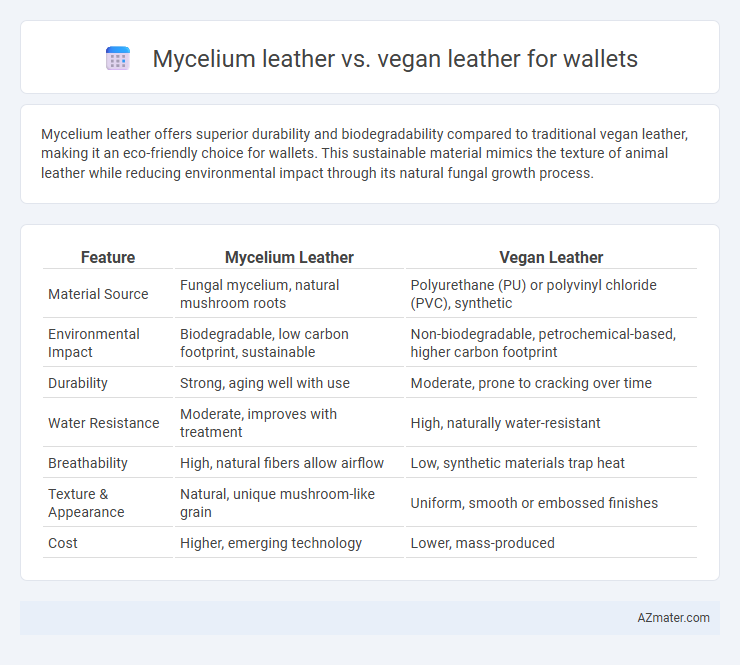Mycelium leather offers superior durability and biodegradability compared to traditional vegan leather, making it an eco-friendly choice for wallets. This sustainable material mimics the texture of animal leather while reducing environmental impact through its natural fungal growth process.
Table of Comparison
| Feature | Mycelium Leather | Vegan Leather |
|---|---|---|
| Material Source | Fungal mycelium, natural mushroom roots | Polyurethane (PU) or polyvinyl chloride (PVC), synthetic |
| Environmental Impact | Biodegradable, low carbon footprint, sustainable | Non-biodegradable, petrochemical-based, higher carbon footprint |
| Durability | Strong, aging well with use | Moderate, prone to cracking over time |
| Water Resistance | Moderate, improves with treatment | High, naturally water-resistant |
| Breathability | High, natural fibers allow airflow | Low, synthetic materials trap heat |
| Texture & Appearance | Natural, unique mushroom-like grain | Uniform, smooth or embossed finishes |
| Cost | Higher, emerging technology | Lower, mass-produced |
Introduction to Mycelium Leather and Vegan Leather
Mycelium leather, derived from the root structure of mushrooms, offers a sustainable and biodegradable alternative to traditional materials, with properties like durability, flexibility, and a natural texture ideal for wallets. Vegan leather, commonly made from polyurethane or plant-based materials such as pineapple leaves or cork, provides cruelty-free options but often varies in environmental impact and durability depending on its composition. Both materials cater to eco-conscious consumers seeking stylish and ethical wallets but differ significantly in origin, biodegradability, and tactile experience.
Production Process Comparison
Mycelium leather is produced by cultivating fungal mycelium that grows into a dense, leather-like material through a low-energy, biodegradable process, minimizing environmental impact. Vegan leather, commonly made from synthetic polymers such as polyurethane or PVC, relies on petroleum-based chemicals and energy-intensive manufacturing, resulting in higher carbon emissions and limited biodegradability. The sustainable cultivation of mycelium offers a faster growth cycle and reduces water and chemical usage compared to the resource-heavy, chemically intensive production of conventional vegan leather for wallets.
Environmental Impact and Sustainability
Mycelium leather, derived from mushroom roots, offers a highly sustainable alternative to vegan leather, which is often made from synthetic materials like polyurethane or PVC that contribute to plastic pollution. The production of mycelium leather requires significantly less water and energy, resulting in a lower carbon footprint compared to both conventional leather and synthetic vegan alternatives. Its biodegradable nature ensures minimal environmental impact at the end of its lifecycle, enhancing its appeal as an eco-friendly choice for wallets.
Material Durability and Longevity
Mycelium leather offers superior durability and longevity compared to traditional vegan leather, as it is made from the root structures of fungi, which provide a naturally resilient and flexible material. Vegan leather, often crafted from polyurethane or PVC, tends to degrade faster due to synthetic components that can crack or peel over time. The innovative fibrous texture of mycelium leather supports better breathability and wear resistance, enhancing the lifespan of wallets made from this sustainable alternative.
Texture, Look, and Feel
Mycelium leather offers a unique, natural texture with a slightly fibrous, organic feel that mimics traditional leather closely while maintaining a breathable quality. Vegan leather, often made from polyurethane or PVC, has a smoother, synthetic surface that can vary in softness but generally lacks the depth and natural grain of mycelium leather. The look of mycelium leather is more matte and rustic, providing a handcrafted appearance, whereas vegan leather often has a shinier, more uniform finish that emphasizes durability.
Cost and Market Availability
Mycelium leather typically costs more than traditional vegan leather due to its innovative production process and limited scale, but it offers potential for sustainable luxury markets. Vegan leather, often made from polyurethane or PVC, is widely available and lower-priced, making it accessible for mass-market wallets. Market availability favors vegan leather with numerous brands offering affordable options, while mycelium leather remains niche, primarily found in boutique and eco-conscious collections.
Ethical Considerations
Mycelium leather offers a sustainable alternative by utilizing mushroom roots that require minimal resources, reducing environmental impact and promoting biodegradability compared to traditional vegan leather made from synthetic materials like polyurethane or PVC, which often rely on fossil fuels and contribute to microplastic pollution. The cultivation of mycelium leather supports circular economy principles and ethical sourcing without animal exploitation, whereas some vegan leathers may involve animal-derived glues or questionable labor practices. Choosing mycelium leather wallets aligns with ethical consumerism by prioritizing eco-friendly production, reduced carbon footprint, and cruelty-free innovation.
Biodegradability and End-of-Life Options
Mycelium leather offers superior biodegradability compared to traditional vegan leather, as it is derived from mushroom roots and decomposes naturally within weeks under composting conditions. Vegan leather, often made from synthetic materials like polyurethane or PVC, can persist in landfills for decades due to its plastic-based composition. End-of-life options for mycelium leather include industrial composting and soil biodegradation, while vegan leather generally requires recycling programs or ends up contributing to plastic pollution.
Consumer Reception and Trends
Mycelium leather is gaining rapid consumer traction due to its sustainability and natural texture, appealing to eco-conscious buyers seeking innovative alternatives. Vegan leather maintains strong market presence with affordability and diverse styles, yet faces criticism for synthetic materials and environmental impact. Trends indicate a rising preference for mycelium leather as brands emphasize biodegradability and ethical sourcing in wallet production.
Choosing the Best Leather Alternative for Wallets
Mycelium leather offers a sustainable and biodegradable option for wallets, made from mushroom root structures that provide a natural texture and durability similar to animal leather. Vegan leather, often crafted from polyurethane or PVC, delivers a wide range of colors and finishes but may lack breathability and environmental benefits due to its synthetic composition. Choosing the best leather alternative depends on prioritizing eco-friendliness and biodegradability, where mycelium leather excels, versus affordability and variety, where vegan leather often leads.

Infographic: Mycelium leather vs Vegan leather for Wallet
 azmater.com
azmater.com